
Providers and Quality of Care
Product: New Perspectives on Quality Care, no. 3
Author: PRB
Date: July 1, 2002
In this series
- This report also in French and Spanish.
New Perspectives on Quality of Care: No. 3
(July 2002) Providers of reproductive health information and services are critical parts of the complex equation that determines quality of care. They are responsible for giving clients the information to make an informed decision about contraceptive use and for ensuring that clients receive needed and competent medical attention. Yet providers’ ability to provide high-quality care, their ultimate goal, is influenced by other factors, including local customs and traditions, medical culture, and the strength of the facility and health care system in which they work.
Who Are Providers?
Providers are health workers, such as doctors, health aides, and midwives, who deliver family planning and reproductive health care services in clinics, hospitals, and communities through outreach services and community-based activities. They work in both public and private settings and at various levels of the health care hierarchy, and may have different levels of education and supervisory responsibility. Providers are also clients of the health care system, in that their work requires the infrastructure, supervision, equipment, and physical setting that the system supplies. In addition, providers, like their clients, are influenced by the local culture, reflecting and often being constrained by local beliefs and biases regarding status, gender, ethnicity, and other social factors.
Why Are Providers Important?
As the main point of contact between clients and the health care system, providers play a major role in identifying and meeting clients’ health care needs. How well they respond to clients’ needs depends on individual practitioners’ technical and interpersonal skills, on the infrastructure of the health care system, and on clients’ perceptions about what defines high-quality care. If providers’ services and behavior do not meet clients’ standards, clients may seek care elsewhere or go without care altogether. In some areas, clients may be forced to accept low-quality care, simply because there are no other providers available.
The U.S. Agency for International Development’s Maximizing Access and Quality Initiative (MAQ) has identified 25 indicators of quality of care: 13 relate to providers’ job performance, eight reflect conditions at the service delivery facility, three reflect clients’ participation in care, and one pertains to other clinic staff (see Policy Brief 1, Overview of Quality of Care in Reproductive Health: Definitions and Measurements of Quality). The ratio of indicators suggests that providers’ job performance and the clinic infrastructure that supports them are among the main determinants of quality of care.
How Do Providers Define Quality of Care?
Information about providers’ perspectives on quality of care is surprisingly limited. Some providers acknowledge that their work environment could be improved, but feel that the situation is not under their control. For example, most of the 54 auxiliary nurse midwives (ANMs) interviewed for a study in India could not define quality services or suggest how family planning services could be improved. Medical officers in the same study focused mainly on inadequacies in the clinic infrastructure and on clinic equipment, supplies, and medicines (Khan et al. 1995). But a study in Kenya found that providers and clients agreed on the importance of certain elements of care, including affordability, convenient location, good provider attitudes, privacy and confidentiality, and availability of supplies (Ndhlovu 1995). In some cases, providers may be reluctant to take steps that would improve the quality of care, feeling that such moves would increase their workload. Providers in Malawi, for instance, feared that making family planning services more convenient for clients would add to staff responsibilities (Tavrow et al. 1995).
Constraints to Improving Quality of Care
A multitude of factors, often appearing in combination, can affect providers’ ability to deliver quality reproductive health services. Common factors include changes in the health care system, strengths or deficiencies within systems or individual facilities, availability of supplies and equipment, regulatory constraints, and providers’ level of competence (Paine et al. 1998).
Macro-Level Changes in Health Systems
Health sector reform in many less developed countries is changing both the financing and delivery of health care services. While reform is intended to expand access to health services and improve the overall quality of care, some changes are likely to disrupt reproductive health services. Decentralizing health care, for example, may lead some authorities to limit reproductive health care services or raise prices. Financial instability in the public health care sector may lead to conflicting organizational priorities and diminished morale or performance among providers (Gauri 2001).
Many programs are reorganizing their services to provide an integrated package of reproductive health services and information, including material and services dealing with maternal and child health, sexually transmitted infections (STIs), HIV/AIDS, and family planning. Shifting to integrated services adds responsibilities and requires that providers be well-versed in several health areas. Such system-wide changes often preoccupy service providers and divert them from improving quality of care. A 1998 report on the health sector reform process in Zambia reported that providers at a Cooperative for Assistance and Relief Everywhere (CARE) clinic felt “powerless, unmotivated, and overworked” and that the lack of medications had led to a decline in client visits (Munro 1998: 43).
Difficult Working Conditions
Conditions within individual clinics or within groups of clinics can be barriers to high-quality care. Many providers believe that their working conditions severely impede their job performance, and complain about poorly equipped facilities, long hours, low pay, and little recognition. More than half of 82 health professionals surveyed in Zambia said they were not satisfied with their working conditions, due to heavy workload, lack of equipment and drugs, poor salary, and lack of continuing education (Faxelid et al. 1997). ANMs interviewed for one study in India said that they were not able to visit all of the villages in their work areas, due to a lack of proper transportation and to meager travel allowances (Khan et al. 1995).
Supervision, an important influence on provider morale and performance, may also be affected by health care reform. An evaluation of eight national family planning programs found supervisory weaknesses in several countries (United Nations Population Fund 1994). Poor supervision often involves cursory inspections and harsh criticism rather than a coaching and mentoring approach that would motivate providers to put forth their best efforts.
Inadequate Supplies
Even when they receive other types of support from the health care system, providers frequently face shortages of basic medical supplies, such as contraceptives, infection control equipment, and gloves. Numerous studies document these shortages. In Bangladesh and India, for instance, only about one-third of providers, community-based service agents, and managers surveyed felt they had the necessary materials to do their work adequately (Huezo 2001; Khan et al. 1995). Two studies of 39 service delivery points in Peru found that most lacked skilled personnel and had inadequate infrastructure, equipment, and supplies (León et al. 1997).
Attitudinal and Regulatory Barriers
Several barriers may limit providers’ ability to provide quality care. Knowledge gaps, including both community “myths” (see Policy Brief 2, Client-Centered Quality: Clients’ Perspectives and Barriers to Receiving Care) and insufficient knowledge and skills among providers, represent one type of barrier (Best 2002). Gender bias and moral constraints can also play a role in limiting care. In Brazil, for example, providers discourage use of female barrier methods and the male condom, believing that women cannot learn to use these methods properly, that partners will not accept their use, and that barrier methods diminish men’s pleasure (Moore and Helzner 1996).
There are also medical barriers and practices based on questionable medical rationales that limit clients’ access to contraception (Shelton et al. 1992). For example, an examination of quality of care in five African countries showed that between 18 percent and 63 percent of providers imposed restrictions on family planning based on clients’ age, marital status, spousal consent, and number of children (Miller et al., “How Providers Restrict Access,” 1998). National policies, such as guidelines stipulating that only certain specialists may perform sterilizations or prescribe injectable contraceptives, can also affect access to quality of care.
Such barriers may prevent clients from obtaining contraceptives, expose them to risk of unwanted pregnancy, and discourage them from seeking other reproductive health services. Yet in most cases, providers are trying to protect their clients.
Insufficient Technical and Interpersonal Skills
Some providers lack the necessary technical and counseling skills to provide high-quality services. For example, in Jamaica, one in eight of the private physicians who offer family planning services said they had not been trained in providing family planning methods, and one in four had no training in counseling (Hardee et al. 1995). Where STIs are prevalent, discussion of clients’ sexual relationships and risks is imperative, but situation analyses in five countries showed that few providers conduct such discussions (Haberland et al. 1998).
Status differences between clients and providers can influence quality of care, although providers’ reactions may differ by region (Schuler and Hossain 1998). In a Kenya case study, providers were far more likely to provide information on contraceptive side effects if clients were older or better educated (Ndhlovu 1995). Since health care traditionally casts providers as decisionmakers who know what is best for their clients, teaching providers the importance of client-centered approaches can help them provide services that are more appropriate for each client (Shelton 2001).
What Do Providers Need?
As the main point of contact between clients and the health care system, providers need various types of support in order to deliver high-quality care. The International Planned Parenthood Federation (IPPF) requires that clients be offered method choice, safe contraceptive practices, privacy, confidentiality, dignity, comfort, and continuity of care (see Policy Brief 1, Overview of Quality of Care in Reproductive Health). To ensure that clients receive these elements of quality services, providers need the appropriate knowledge, skills, supplies, clinical environment, and motivation.
Interventions to Improve Quality of Care
Before attempting to improve the quality of care, it is important to determine what factors contribute to lower-quality care. Quantitative approaches and self-assessment tools, such as Continuous Quality Improvement (CQI), Client-Oriented Provider-Efficient services (COPE), and Performance Improvement (PI), can help organizations determine strengths and weaknesses in service delivery and help identify solutions (see Policy Brief 1, Overview of Quality Care in Reproductive Health).
It is also vital to understand what can motivate medical staff to provide high-quality care. There is little data about why providers persevere under difficult conditions or about what would motivate them to make additional efforts to improve the quality of their care, although providers’ main motivation seems to be their desire to do something good for others or to give back to the community (Tavrow et al. 1995; Huezo 2001). Understanding providers’ needs and motivations can help those interested in designing ways to improve quality of care.
Experts have developed several interventions, largely under the control of managers of reproductive health facilities and programs, that could lead to better provision of reproductive health services. But despite widespread application, the options have not yet been rigorously tested through controlled experiments. Most programs use multiple interventions, so it is difficult to determine the effectiveness of any single intervention. In general, the most effective interventions seem to be those that combine multiple approaches.
Develop Service Standards and Guidelines
Experts recommend that national and local program managers adopt service delivery guidelines that reflect scientifically rigorous, internationally accepted norms or best practices. For example, the World Health Organization (WHO) and its partners launched Implementing Best Practices (IBP) in Reproductive Health to ensure that internationally recognized norms and standards in care were widely adopted. The IBP initiative gets key national decisionmakers involved in applying evidence-based best practices to local health systems. After networks of interested groups are established, participants share what they have learned, conduct a problem analysis, plan and implement appropriate interventions, and assess the interventions’ impact (Consortium on Implementing Best Practices 2001). Both providers and their supervisors should be trained in using the guidelines to maximize the guidelines’ effect on quality of care (Best 2002).
Upgrade Logistics and Support Systems
Ensuring that organizational systems function efficiently is a key element in providing quality care. Procedures for financing, accounting, and managing client flow should be structured to support high-quality care. Logistics systems need to be strengthened to ensure that providers receive the necessary contraceptives, clinic supplies, and other equipment.
Even improving the availability of one specific type of supply, such as contraceptives, can affect the quality of care. Studies in Kenya and Tanzania found that a decrease in the number of contraceptive stockouts (absence of one or more products) was associated with an increase in contraceptive prevalence (see Figure 1). In Jordan, a reduction of stockouts coincided with an increase in the number of contraceptives distributed (Family Planning Logistics Management/John Snow, Inc. 2000).
Figure 1
Contraceptive Stockouts and Contraceptive Prevalence in Tanzania
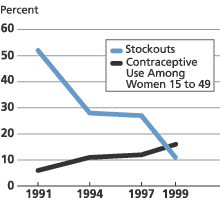
Source: Family Planning Logistics Management/John Snow, Inc., Programs That Deliver (2000): 7.
However, a case study in Kenya has shown that quality of care does not always improve even when clinics are fully equipped and have staff who are sufficiently trained to provide quality service (Ndhlovu 1998). An examination of family planning services in five African countries showed that deficits in services were due not to scarcity of resources, but rather to providers’ underutilization of existing supplies, such as water for washing hands (Haberland et al. 1998). Reproductive health organizations need to ensure that policies, protocols, and staff management work together to facilitate the efficient use of available support systems.
Improve Provider Training
Experts often suggest training to improve providers’ knowledge. Training can take a variety of forms, but effective training methods share certain characteristics.
A specific focus Limiting the focus of training to one area is generally more useful than having a broader focus. Studies and situation analyses in Africa show that intensive, focused training in specific skills and knowledge affects quality more than general training does (Miller et al., Clinic-Based Family Planning, 1998). In Egypt, the ministry of health introduced a training program for nurses that spent more time on teaching practical skills and less time on theoretical issues. The study found that clients in the experimental clinics became more knowledgeable about family planning, and IUD use increased significantly in one area (Halawa et al. 1995).
Attention to interpersonal communication Since providers must be able to work closely with their clients on a variety of sensitive topics, successful training emphasizes communication skills. In Nigeria, nurses trained in counseling provided higher-quality care than a control group did, as perceived by clients and observed by a counseling expert. The clients of the trained nurses were also more likely to return for a follow-up visit (Kim et al. 1992).
Hands-on exercises Trainees who get a chance to practice what they have learned before returning to the field often do better than those who do not have the opportunity. In a study in Thailand, two training approaches were used to teach 300 midwives to insert IUDs. The traditional training consisted of a classroom lecture, followed by clinical practice. The alternative approach also used anatomical models and clinical guidelines. The midwives trained using the alternative approach achieved competency after an average of 1.6 insertions, compared with 6.5 insertions for the traditionally trained group (Limpaphayom et al. 1997).
Reinforcement Practitioners are more likely to retain what is taught in training if they regularly use the skills and get periodic refresher courses. A study in Kenya found that providers who received training in client examination and counseling were more likely to retain the material if they put their new skills to use. The use of skills was more important than elapsed time since training in determining whether providers retained the skills (Valadez et al. 1997).
Strengthen Staff Supervision and Management
Program management can either contribute to improved provider performance or work against the delivery of high-quality care. In Eritrea, for example, unclear job descriptions, delays in promotions, and the absence of supportive supervision have contributed to low morale and poor performance, leading to poor quality of care (Family Planning Service Expansion and Technical Support/John Snow, Inc. 2000).
Motivating supervisors to provide more effective supervision can foster a top-down commitment to quality. EngenderHealth recommends encouraging facilitative, rather than traditional, supervision (Ben Salem and Beattie 1996). Facilitative supervision emphasizes mentoring, joint problemsolving, and two-way communication between supervisors and providers, and can encourage providers to improve their job performance. Providing training to supervisors in Ghana not only increased their knowledge and skills, but it also had a positive impact on the community-based distribution agents they supervised (Combary et al. 1999).
Employees in reproductive health care frequently work without formal job descriptions, feedback, or understanding of where their work fits in with their organizations’ goals (Lande 2002). Supervisors who recognize and reward employees who provide high-quality services support providers’ motivation to deliver quality care (Jennings et al. 2000).
Supervision is often logistically difficult: Supervisors may be unable to visit every health post in their region or to spend enough time in each clinic (Ahmed 1994; Valadez et al. 1990). Several alternatives to traditional supervision have been tested.
Group supervision Two studies in Kenya and Guatemala found that group supervision, in which a supervisor meets with four or five local providers at one time, was as effective as individual supervision and allowed supervisors to cover a larger geographic area at a lower cost (Jacobson et al. 1987; Vernon et al. 1994).
Team-based work with supervisors and providers In Zimbabwe, findings from a study of supervisors’ interactions with providers led policymakers to shift from a top-down supervisory approach to a team-based approach, in which supervisors and providers share responsibilities and work as partners (Kim et al., “Self-Assessment and Peer Review,” 2000). These promising new approaches may help providers develop and maintain quality services.
Provide Self-Assessment Tools
Self-assessment is another alternative to traditional supervision. Self-assessment tools, such as COPE, enable providers to identify problems and develop their own solutions, although such tools cannot solve problems that lie outside the control of clinic staff, such as staffing or supply shortages. An evaluation in 11 African sites found that 73 percent of the problems that could be solved without outside help, such as long waiting times and communication and morale problems, were solved using COPE (Lynam et al. 1993).
Self-assessment tools can also reinforce knowledge and skills and increase productivity: In Indonesia, over 200 providers attended a training course on client-centered counseling before being divided into three groups. The first group received no follow-up, the second conducted weekly self-assessments, and the third attended peer-review meetings and performed weekly self-assessments. The study determined that self-assessment and peer review helped maintain providers’ improved performance after training (Kim et al., “The Quality of Supervisor-Provider Interactions in Zimbabwe,” 2000).
Ensure That Providers Use Job Aids
Job aids, including manuals, posters, flipcharts, and flowcharts, can be valuable tools. The materials are inexpensive and can take the place of costly, time-consuming off-site training (Knebel et al. 2000).
Job aids can help clients choose the method that matches their reproductive goals. For example, a situation analysis in Kenya found that providers who used contraceptive samples and anatomical models during their counseling sessions gave clients more information about their chosen contraceptive method, including how to use it, possible side effects, and how to manage problems (Ndhlovu 1998).
But many providers fail to use job aids: Some providers feel that using such materials decreases their credibility with clients; others are inadequately trained and supervised in using job aids. In one study in Peru, only 44 percent of providers trained to use a job aid actually did so. Those who did provided a much higher quality of care, based on a checklist of 80 expected provider behaviors (see Figure 2; León et al. 1998; León 2001).
Figure 2
How Use of Job Aids Affected Quality of Care Scores for Peruvian Providers
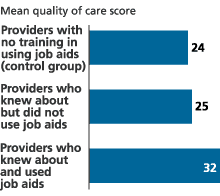
Source: F. León, Peru PCI-QOC Project Bulletin (2001).
Policy Implications
Providers and the health systems that support them play a vital role in improving the quality of reproductive health care. But improving care requires a commitment from all levels of the health care system. Policymakers can provide leadership by calling for quality services and ensuring that the necessary support systems are in place to help providers meet quality standards. Program managers should create a supportive climate that rewards providers who strive to supply quality services, and must be responsible for logistical support to ensure that medicines and other supplies are readily available. Both policymakers and program managers can support research to test the interventions commonly used to improve quality of care, ensuring that the interventions make a difference. With adequate support and supervision, providers can provide quality services, thereby increasing client satisfaction and improving overall reproductive health.
Kristina Lantis, Cynthia P. Green, and Stephanie Joyce of FRONTIERS prepared this brief in collaboration with John Townsend of the Population Council and Liz C. Creel, Justine V. Sass, and Nancy V. Yinger of the Population Reference Bureau. The Population Council gratefully acknowledges the U.S. Agency for International Development (USAID) for supporting this project. This policy brief was funded through FRONTIERS and MEASURE Communication, through Cooperative Agreements No. HRN-A-00-98-00012-00 and HRN-A-00-98-000001-00, respectively. Special thanks are due to the following reviewers: Michal Avni, Sarah Harbison, James Shelton, and Kellie Stewart, of the USAID Bureau for Global Programs, Office of Population; Ian Askew, James Foreit, Anrudh Jain, Federico León, Saumya RamaRao, Laura Raney, and John Townsend, Population Council; Jane Bertrand, Johns Hopkins University School of Public Health, Center for Communication Programs; Elaine Murphy, Program for Appropriate Technology in Health; Jan Kumar, EngenderHealth; and Abbas Bhuiya, International Center for Diarrheal Disease Research, Bangladesh.
References
A.M. Ahmed et al., “The National Guidelines for Supervision Checklist: A Tool for Monitoring Supervision Activities at District Level in Tanzania,” Annali di Igiene 6 (1994): 161-66.
Beverly Ben Salem and Karen J. Beattie, “Facilitative Supervision: A Vital Link in Quality Reproductive Health Service Delivery,” AVSC Working Papers, no. 10 (New York: EngenderHealth, 1996).
Kim Best, “Medical Barriers Often Unnecessary,” Network 21, no. 3 (2002): 4-15.
Jagdish C. Bhatia, “A Qualitative Study of Family Planning (Welfare) Services at the Primary Health Centre (PHC) Level in the State of Karnataka” (Bangalore, India: Indian Institute of Management, 1995).
P. Combary et al., “Study of the Effects of Technical Supervision Training on CBD Supervisors’ Performance in Seven Regions of Ghana,” Technical Reports, no. 7 (Chapel Hill, NC: INTRAH, 1999).
Consortium on Implementing Best Practices, “The IBP Initiative: Implementing Best Practices in Reproductive Health” (Geneva: World Health Organization, 2001).
Family Planning Logistics Management/John Snow, Inc., Programs That Deliver: Logistics’ Contributions to Better Health in Developing Countries (Arlington, VA: Family Planning Logistics Management/John Snow, Inc., 2000).
Family Planning Service Expansion and Technical Support (SEATS II)/John Snow, Inc., “Mainstreaming Quality Improvement in Family Planning and Reproductive Health Services Delivery: Context and Case Studies” (Arlington, VA: Family Planning Logistics Management/John Snow, Inc., 2000).
Elisabeth Faxelid et al., “Quality of STD Care in an Urban Zambian Setting: The Providers’ Perspective,” International Journal of Nursing Studies 34, no. 5 (1997): 353-57.
Varun Gauri, “Are Incentives Everything? Payment Mechanisms for Health Care Providers in Developing Countries,” World Bank Working Papers, no. 2624 (Washington, DC: World Bank, 2001).
Nicole Haberland et al., “Unrealized Quality and Missed Opportunities in Family Planning Services,” in Clinic-Based Family Planning and Reproductive Health Services in Africa: Findings From Situation Analysis Studies, ed. Kate Miller et al. (New York: Population Council, 1998).
M. Halawa et al., “Assessing the Impact of a Family Planning Nurse Training Program in Egypt,” Population Research and Policy Review 14, no. 4 (1995): 395-409.
Karen Hardee et al., “Assessing Family Planning Service-Delivery Practices: The Case of Private Physicians in Jamaica,” Studies in Family Planning 26, no. 6 (1995): 338-49.
Carlos Huezo, “Improving the Quality of Care by Improving the Motivation of Service Providers: A Study Based in Uganda and Bangladesh” (paper presented at MAQ Mini-University, Washington, DC, April 20, 2001).
M.L. Jacobson et al., “Individual and Group Supervision of Community Health Workers in Kenya: A Comparison,” Journal of Health Administration Education 5, no. 1 (1987): 83-94.
Victoria Jennings et al., “Analyzing the Organizational Context for a Positive Client-Provider Interaction: A Leadership Challenge for Reproductive Health,” MAQ Papers 1, no. 1 (Washington, DC: U.S. Agency for International Development, 2000).
M.E. Khan et al., Quality of Family Planning Services from Provider’s Perspective: Observations From a Qualitative Study in Sitapur District, Uttar Pradesh (New Delhi, India: Population Council, 1995).
Young Mi Kim et al., “Improving the Quality of Service Delivery in Nigeria,” Studies in Family Planning 23, no. 2 (1992): 118-27.
Young Mi Kim et al., “Self-Assessment and Peer Review: Improving Indonesian Service Providers’ Communication with Clients,” International Family Planning Perspectives 26, no. 1 (2000): 4-12.
Young Mi Kim et al., “The Quality of Supervisor-Provider Interactions in Zimbabwe,” Operations Research Results 1, no. 5 (Bethesda, MD: Quality Assurance Project, 2000).
E. Knebel et al., “The Use of Manual Job Aids by Health Care Providers: What Do We Know?” QA Issue Papers, no. 1 (Bethesda, MD: Quality Assurance Project, 2000).
Robert E. Lande, “Performance Improvement,” Population Reports, Series J, no. 52 (Baltimore: Johns Hopkins University School of Public Health, Population Information Program, 2002).
Federico R. León, Peru PCI-QoC Project Bulletin, no. 6 (Lima, Peru: Population Council, 2001).
Federico León et al., “Quality of Care and User Outcomes in the Province of Santa, Peru: Two Diagnostic Studies with Focus on Providers and Users” (Lima, Peru: Population Council, Ministry of Health, Chavín Health Region, La Caleta Health Network, E. Guzmán Barrón Health Networks, and U.S. Agency for International Development/Peru, 1997).
Federico León et al., “Developing Algorithmic Instruments to Help Providers and Users to Implement the New Reproductive Health Care Guidelines” (Mexico City: Population Council, 1998).
Kobchitt Limpaphayom et al., “The Effectiveness of Model-Based Training in Accelerating IUD Skill Acquisition: A Study of Midwives in Thailand,” British Journal of Family Planning 23 (1997): 58-61.
Pamela Lynam et al., “Using Self-Assessment to Improve the Quality of Family Planning Clinic Services,” Studies in Family Planning 24, no. 4 (1993): 252-60.
Kate Miller et al., eds., Clinic-Based Family Planning and Reproductive Health Services in Africa: Findings From Situation Analysis Studies (New York: Population Council, 1998).
Kate Miller et al., “How Providers Restrict Access to Family Planning Methods: Results From Five African Countries,” in Clinic-Based Family Planning and Reproductive Health Services in Africa: Findings From Situation Analysis Studies, ed. Kate Miller et al. (New York: Population Council, 1998).
Kirsten Moore and Judith F

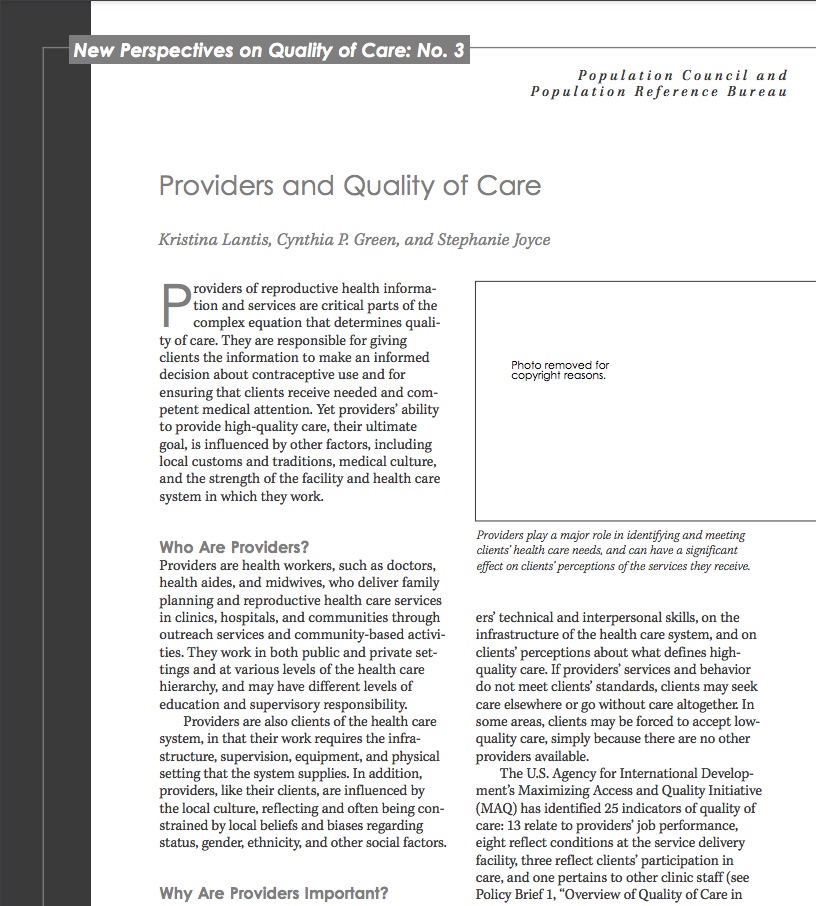 ">
">
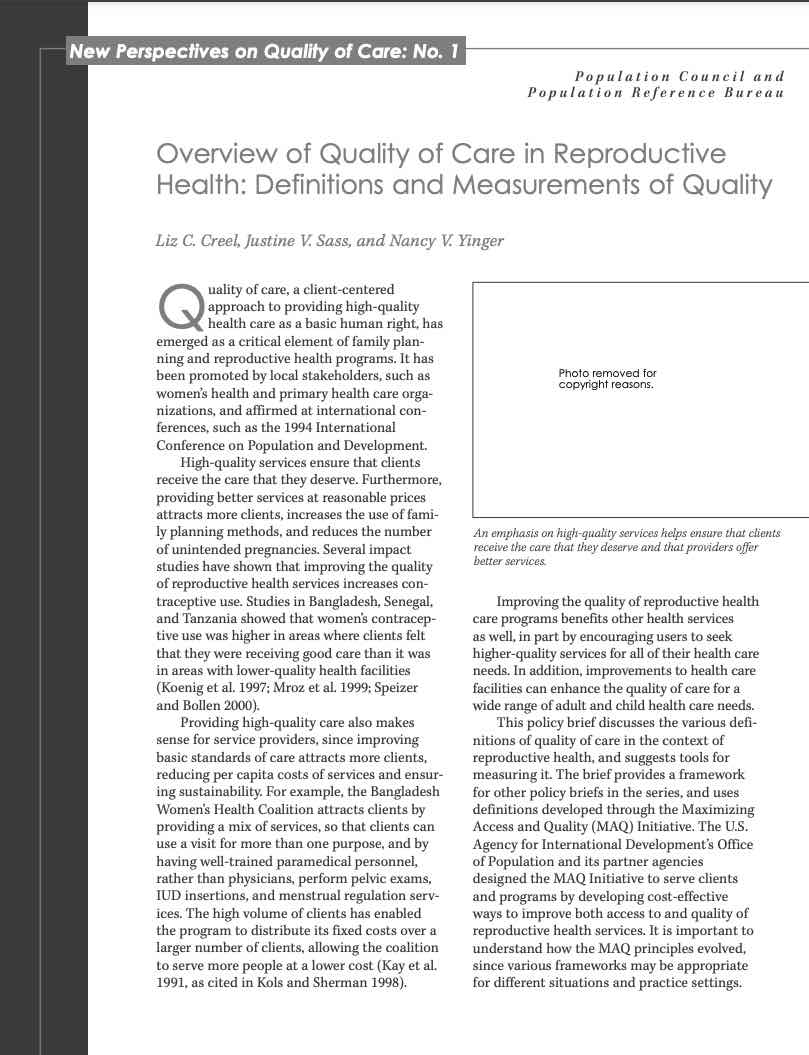 ">
">
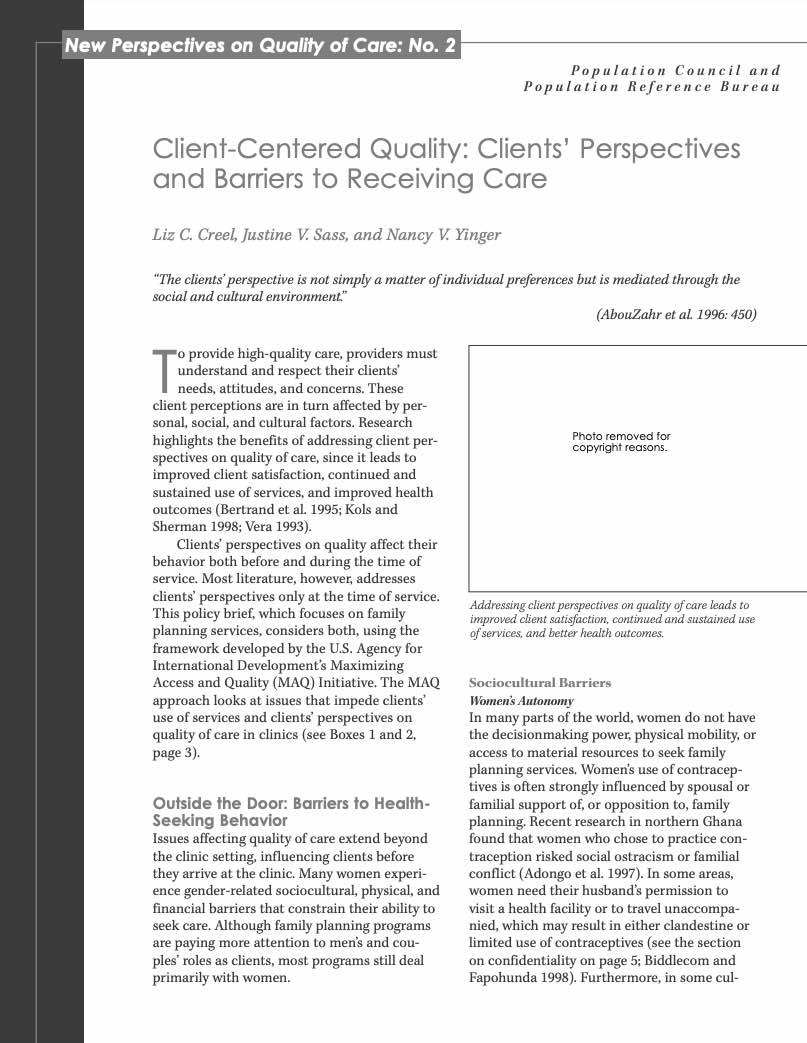 ">
">